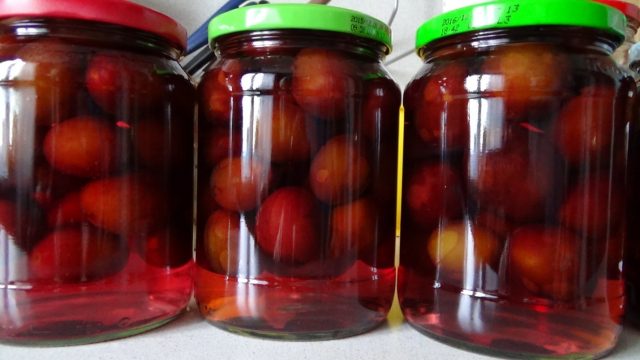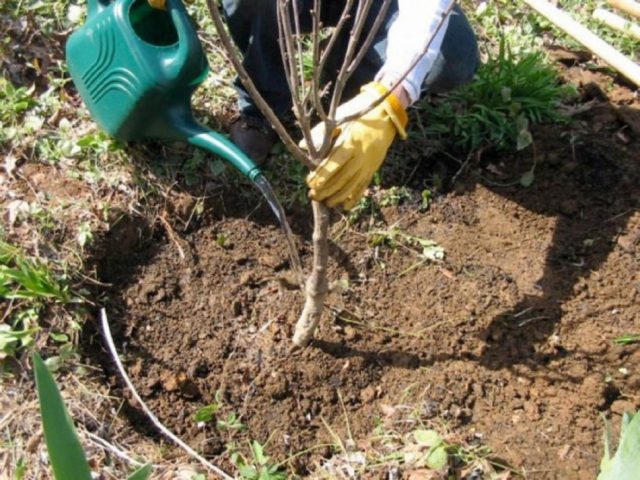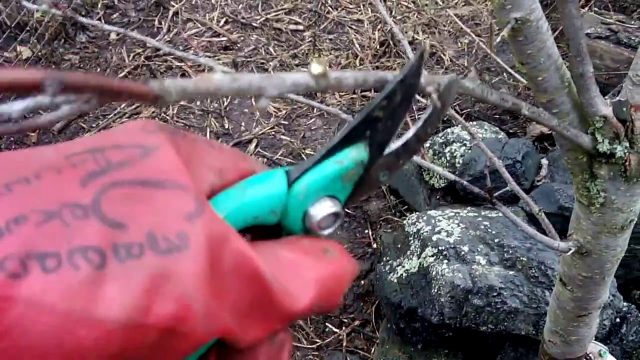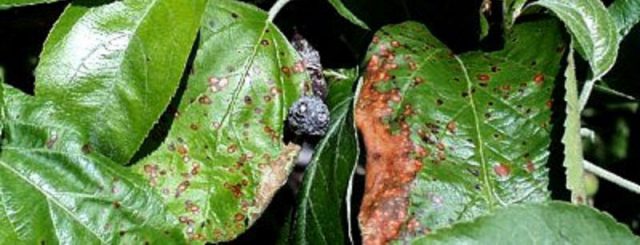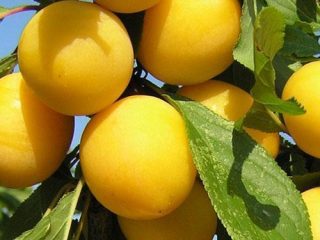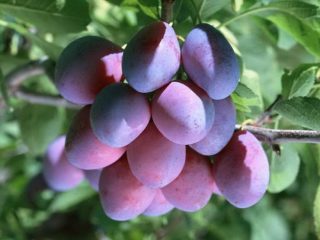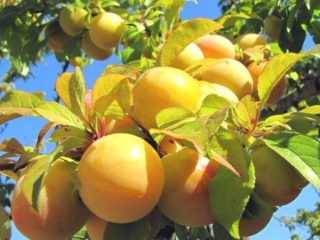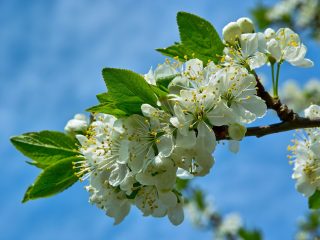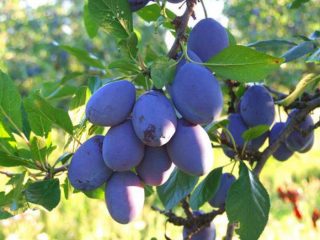Content
The Imperial plum is a columnar variety. The culture has just begun to spread among domestic gardeners. The compact tree does not require much care, bears fruit abundantly, and takes up little space in the garden. Plum can rightfully be called commercial due to the exquisite taste of the fruit and good transportability of the harvest.
History of variety selection
Varieties of columnar plums not so much. Imperial is a worthy representative of this group. The author of the variety is the domestic breeder Eremin G.V. At the moment, there are very few reviews about the columnar plum Imperial. However, some owners of small plots have already appreciated the compact tree from the best side.
Description of the columnar plum variety Imperial
The shape of the tree resembles a column, a narrowed pyramid or a candle, medium covered with small oval leaves. The leaf blade is bright green. There is a gloss on the front side of the sheet. The Imperial variety tree grows from 1.5 to 2 m in height. The tree consists of a trunk, annual fruiting branches and ringlets. There are practically no side branches; if they grow, they are very few.
The fruits of the Imperial variety are densely located throughout the entire crown of the tree. Plums are usually pink in color. Sometimes a purple tint may appear. Less common is the columnar variety Imperial with brown fruits. They taste no different from their pink counterparts. The average weight of the fruit is 55 g. The pulp is golden in color, tender with a honey flavor. Slightly acidic.
The flowering of the columnar plum Imperial begins early. In early May, the tree is abundantly covered with flowers. All inflorescences are female. In the middle zone and other cold regions, the Imperial variety takes root, but Kuban is considered the best area for cultivation. The well-columnar plum has spread in the gardens of the Ciscaucasia.
Characteristics of the variety
To get better acquainted with the columnar plum variety, it is worth taking a closer look at the characteristics of the crop.
Drought resistance, frost resistance
The columnar variety Imperial is considered winter-hardy. Fruit buds and wood are resistant to freezing. Only young trees under three years of age are highly sensitive to frost. Seedlings of the Imperial variety are wrapped in non-woven material before the onset of winter. The shelter protects the non-lignified bark of a young plum from freezing. In the fourth year, the tree does not need to be wrapped.
The drought resistance of the Imperial plum is average, even weak. Here again it is worth paying attention to the root system. In the columnar variety, most of the roots grow in the surface layer of soil. During drought, they are not able to independently extract moisture from the depths of the earth. In hot summers, the tree requires frequent watering.
Pollinators of the Imperial plum
Despite the fact that the columnar plum Imperial is self-fertile, it needs pollinators. The following varieties are considered the best:
- Variety Renclod Altana begins to bloom at the end of April. The fruits ripen in August - early September.
- Stanley variety begins to bloom in mid-April. The fruits ripen at the beginning of September.
- Variety Bluefry blooms from mid to late April. The fruits ripen in September.
As pollinators, Stanley and Bluefry varieties are best chosen in warm areas and regions with a temperate climate. In the north, the fruits of these crops simply do not have time to ripen.
Productivity and fruiting
A feature of the columnar plum Imperial is its early fruiting. The harvest can be harvested already in the second year after planting the seedling. The average lifespan of a tree is 15 years. From two to seven years, the crop yield constantly increases. From seven to ten years the indicator remains the same. Further, the yield begins to decline. At 13-17 years of life, the Imperial plum may completely stop bearing fruit. However, the tree does not die and can be used simply to decorate the garden.
The fruits ripen in mid-August. From one tree, 10 to 12 kg of plums are harvested. Ripe fruits do not fall off and can hang on the branches for a long time. Picked plums are stored for up to 10 days.The harvest can be transported.
Area of application of berries
Columnar plum fruits are universal. The fruit is eaten fresh. Imperial plums make delicious compotes, preserves, and jams. Can be used for whole preservation and in slices. Fans of alcoholic beverages prepare tinctures from plums.
Resistance to diseases and pests
The columnar variety Imperial has the same pests as ordinary plums. The harvest is destroyed by the codling moth and sawflies. Hole spots may appear. Fungi that cause rot are dangerous. The Imperial variety is considered resistant to all diseases and pests, subject to preventive spraying.
Advantages and disadvantages of the variety
Positive and negative qualities will help to briefly characterize the Imperial variety. Among the advantages can be noted:
- Imperial is the only self-fertile columnar variety. Even if there is no pollinator nearby, the tree will bear fruit.
- Large tasty fruits.
- Compact crown, requiring virtually no pruning. Only damaged and dry branches are removed.
- Limited tree height to 2 m.
One of the disadvantages is the short lifespan of a columnar tree. This happens due to the drying out of the lower rings.
Planting and caring for the columnar plum Imperial
The variety will appeal to all novice gardeners, since planting and caring for the Imperial plum does not require complex actions.
Recommended timing
Imperial columnar plum seedlings are planted in the middle zone and other cold regions in the spring. This must be done before the buds awaken, but the earth must completely thaw and warm up slightly.In the south, seedlings are planted in the fall. They manage to take root and endure mild winters.
Choosing a suitable location
The columnar variety Imperial loves a bright sunny area, protected from drafts and north winds. Due to the shallow root system, an area with moderately moist soil is considered optimal. Swampy areas are not suitable for plums.
What crops can and cannot be planted nearby?
If the area of the plot allows, then the plum loves to grow alone. However, such conditions are rare. In many dachas, apple, cherry, and pear trees grow next to plum trees and bear fruit normally. Although, if you take a pear, then it is a bad neighbor. Plum gets along well with apple trees and black currants. It is strictly forbidden to plant any walnut, birch, poplar or fir nearby.
Selection and preparation of planting material
A peculiarity of growing the Imperial columnar plum is the fact that for planting you need to buy only one-year-old seedlings. This choice is due to the early entry of the crop into the fruiting phase. Traditionally, seedlings are selected without damage and with living buds. The root system can be open or closed. In the second case, the seedling’s engraftment occurs faster.
Landing algorithm
A feature of the columnar plum is the compactness of the crown. Seedlings can be planted even at a distance of 0.5 m. For mass plantings, maintain a row spacing of at least 1.2 m.The holes in the rows are placed with a slight offset, adhering to a checkerboard pattern.
The size of the planting hole is determined by the size of the root system. The hole is always dug twice as large. When planting, only compost is added as fertilizer. Mineral complexes are not used. There is a danger of burning the roots of a young seedling. Before the plum takes root, watering is carried out with water with the addition of a growth stimulator.
The video shows planting a columnar plum:
Aftercare for plums
The ease of caring for a columnar tree is that there is no need for pruning. The plum itself forms the crown. If necessary, cut out only broken and dry branches. The tree is not tall. There is no need to limit growth by cutting off the top. The central trunk can be shortened by three buds, provided that it is weak and does not produce growth.
Watering is needed regularly - once a week. Plum trees especially need moisture in June and July, when new flower buds are formed. At least 1 bucket of water is poured under the root.
Feeding of seedlings begins only in the third year. During flowering, dilute a solution of 1 bucket of water and 2 tbsp. l. urea. 2 liters of liquid are poured under the tree. Repeat feeding after 2 weeks.
Rodents love to eat the young bark of seedlings. The trunks are protected from hares with spruce branches. You can use pine and juniper. The branches are tied with the needles down. The barrier for mice is the trampled snow around the trunk. Small rodents do not move on the surface in winter. Mice can only penetrate through loose snow. You can also use special nets to protect against rodents. Ruberoid is a bad choice. The roofing material will protect the bark from rodents, but due to the resin impregnation it will create chemical burns.The tree may die. It is unacceptable to treat trunks with petroleum products: grease, kerosene, oil.
Diseases and pests, methods of control and prevention
Fruit trees are always of interest to pests. You should not rely on the sustainability of the variety. Annual preventative treatment with insecticides and fungicides will save the crop. You cannot spray during flowering. The treatment is done before the buds appear and at the beginning of the ovary.
Conclusion
You can even grow a columnar fruit tree near a house or gazebo. The Imperial plum will decorate your yard and, in addition, will bear delicious fruits.





